Table of contents
- Oil change and oil level check Tips from professionals
- Oil level check
- The right oil
- Oil change
- More about technology
- Fill in engine oil
- Practical accessories
- This is required for changing the oil
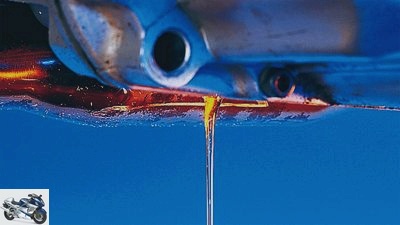
Photo: mps photo studio
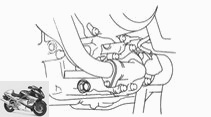
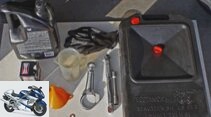
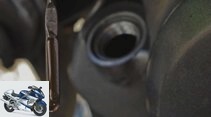
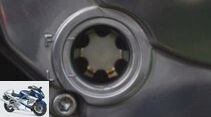
14th pictures
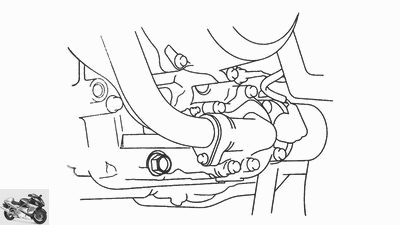
Honda
1/14
Screwdriver tip – oil change and oil level check.
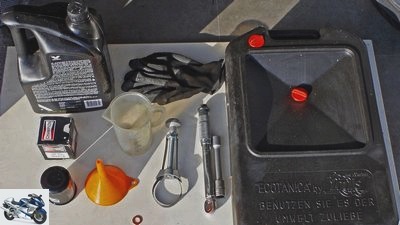
Ralf Petersen
2/14
Preparation: All of this is needed.

Ralf Petersen
3/14
1. Control is better: Check with a warm engine with a dipstick.
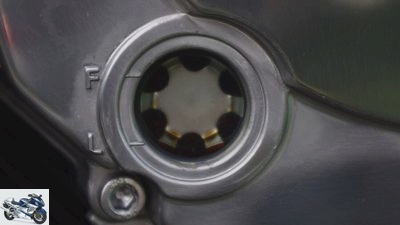
Ralf Petersen
4/14
2. Looks simple, but takes practice: the sight glass check.

Ralf Petersen
5/14
3. Work cleanly: Cover the floor, position the oil pan.
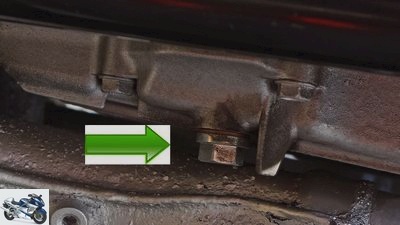
Ralf Petersen
6/14
4. Found the lowest point? The oil drain plug on the oil pan.
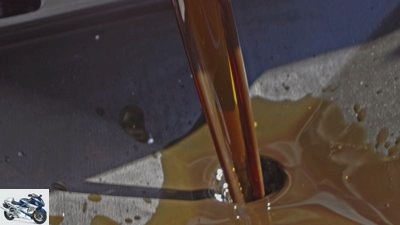
Ralf Petersen
7/14
5. Everything has to come out – drain the oil and let it drip out completely.
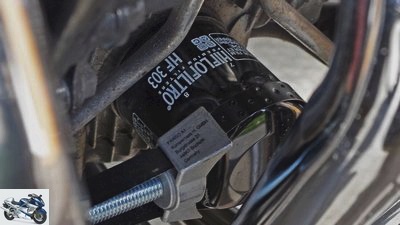
Ralf Petersen
8/14
6. Loosen the oil filter with a wrench, but only tighten it hand-tight.

Ralf Petersen
9/14
7. Label control: which oil for which machine type?
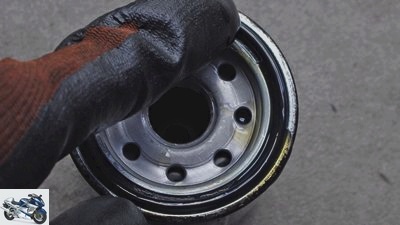
Ralf Petersen
10/14
8. The rubber seal of the oil filter must be lightly oiled.

Ralf Petersen
11/14
9. Not too much of a good thing: Pay attention to the correct filling quantity.

Ralf Petersen
12/14
10. Not too tight: Tighten the drain plug carefully.

Ralf Petersen
13/14
11. A clean affair: Stahlbus oil drain valve as an accessory.

Ralf Petersen
14/14
12. Ideal time for retrofitting: oil temperature display.
counselor
workshop
Screwdriver tip oil change and oil level check
Oil change and oil level check
Tips from professionals
Whether football, business or motor: Everywhere is lubricated. This is not always wanted, but sometimes it is indispensable: for a long motorcycle life, checking the oil level and changing the oil regularly is the top priority. We show how to do it.
Ralf Petersen
May 14, 2018
The oil is a kind of all-rounder in the engine. But like all lubricants, it ages and must therefore be changed at regular intervals. Checking the oil level is just as important as changing, because only a correct oil level protects against damage. After all, oil consumption is also an important indicator of the engine’s state of wear.
Buy complete article

Oil change and oil level check
Tips from professionals
4 pages) as PDF
€ 2.00
Buy now
Motor oil is a complex product that consists of a base of mineral or synthetic oil to which a cocktail of additives is mixed in order to be able to perform various tasks. All engine oils lubricate connecting rod and crankshaft bearings, camshafts and cylinder sliding surfaces and cool the engine. Since most motorcycle engines are connected to the transmission as a unit and often also have an oil bath clutch, special additives are required so that the clutch does not slip and the oil is not destroyed by the shear forces of the transmission gears.
Oil level check
If the engine runs with too little oil, this leads to increased wear and tear, in the absence of adequate lubrication, and even to engine damage. In the opposite case, if too much oil has been filled in, the engine loses power, because in this case the oil brakes the moving parts. This can make it frothy and lose its lubricity. In addition, the oil pressure inside the engine increases and leads to defective seals or enters the air filter via the crankcase ventilation. The oil level changes because a certain amount of oil consumption is normal, but it should not be more than 0.4 l for water-cooled motorcycles and 0.7 l per 1000 km for air-cooled motorcycles. In special cases (e.g. by diluting gasoline) the oil level can also increase. Regular checks are therefore essential.
The correct oil level is measured when the engine is warm (approx. 80 degrees) and has stood for five to ten minutes so that the oil could run back. In an engine with three liters of oil, the difference between a cold and a warm engine can be more than 100 cm³! Most motorcycles have wet sump lubrication; H. the oil supply is in the oil pan. When measuring with a dipstick, you have to know whether the dipstick is only to be attached or if it has to be screwed in completely (see driver’s manual). You don’t have this problem with the oil sight glass. With both types, however, the machine has to be upright – not that easy with motorcycles without a main stand. With the dipstick you can sit on the machine, with the sight glass you need yoga experience or a second person. Ideally, the oil level should be half to three quarters of the way between “min” and “max”. But be careful: Depending on the model / design, there are different procedures for the inspection (e.g. testing on the side stand, etc.). A few motorcycles (e.g. BMW F 650) have dry sump lubrication. The oil is located here in a separate tank, where the dipstick is usually located. It is essential to follow the relevant instructions!
The right oil
There are three types of engine oil: mineral, semi-synthetic and synthetic engine oil. If the manufacturer prescribes a certain oil, there is no need for any discussion if you do not want to lose warranty or goodwill claims. The correct amount, viscosity and specifications can be found in the vehicle manual.
Which oil to use is not least a question of faith that is often debated in forums with fundamentalist enthusiasm. But if you make yourself knowledgeable, you will find out amazing things. It does not always have to be the most expensive and only supposedly the best oil. In tests, cheap oils occasionally beat even the best branded products, and experience from Internet forums shows that not every engine, especially the clutch, can handle every oil. It is obvious that traders like to sell synthetic oil, because it is significantly more expensive, so the profit margin is larger. Incidentally, all oils can in principle be mixed with one another. When buying, you should pay attention to the following things:
Viscosity: Viscosity is the measure of the viscosity of an engine oil. The oil must adapt to the thermal conditions of the engine. If the engine is cold, it must be thin. If the temperature rises, a sufficient lubricating film must be guaranteed. Normal motorcycles that use mineral oil usually use 10W-40 or 15W-40. Synthetic oils usually have a wider range of viscosity, e.g. B. 5W-50.
Quality: The best-known quality standard for oil (but it does apply to car engines) is the API standard (from the American Petroleum Institute). In petrol engines, it has an S as the first letter, and the following letter indicates the performance standard. There is also the Japanese JASO standard, the most important classification for motorcycle engine oils. For motorcycle engines with wet sump-lubricated clutches and gears, oils of the JASO MA / MA-2 standard are particularly suitable.
Oil change
As oil ages, it needs to be changed regularly. Either after a certain mileage or, in the case of occasional drivers, after a certain time. Many older motorcycles still have the 6,000 km intervals, newer types 10,000 km or 12,000 km or require a change every two years. The oil filter should also be replaced at the same time. If the engine oil change interval is almost reached anyway, an oil change before the winter break makes perfect sense. Older oil only has a part of the corrosion protection that fresh oil has, which also does not contain any aggressive components resulting from combustion.
The oil change is one of the relatively simple maintenance work and, with a little planning, is not a problem for the layman either, because in contrast to the car, the drain plug, oil filter and filler neck can usually be reached easily. But a little planning is essential.
You need: the appropriate amount of fresh oil, a measuring cup, the new oil filter, a new seal for the drain plug, a suitable funnel and, if you have filled in too much oil, a syringe with a hose for suction. Of course, the right tool for loosening the oil drain plug and a container for the used oil should not be missing. This is available in the accessories as a practical combination of tub and container. If trim parts etc. have to be removed for the change, the required tools are also kept ready. A torque wrench as well as the tightening values for the oil drain plug and possibly the filter housing are also important, because the sensitive threads in the engine block can be easily damaged. Intelligently, you cover the garage floor sensibly and take care not to leave any containers open.
More about technology
PS knowledge: technology
- Motorcycle technology clearly explained on 97 pages (PDF)
- From starter to spark plug
- Simple teaching of physical principles
- Tips and tricks for practitioners
To the PDF for € 9.99
Fill in engine oil
The correct temperature is important when changing the oil. The engine should be warm (approx. 15 km driving distance / 80 degrees). Then the oil is changed as quickly as possible so that the suspended matter does not settle again on the inner wall of the engine. This is exactly what happens when the oil is changed when the engine is cold. Caution, as the oil is still relatively hot, it is essential to wear protective gloves when unscrewing the drain plug – risk of burns! Two mishaps are now typical. On the one hand, the screw falls into the pan, on the other hand, the oil pan is incorrectly positioned or the oil shoots further out of the drain than expected. That’s why I only remove the filler neck after removing the drain plug. Now the oil can drain well and the old oil filter can be unscrewed. There are two different types of filters. Cartridge oil filters are similar to a tin can and are completely unscrewed. Unscrewing is made easier with an oil filter wrench or attachment. With the other design, an oil filter housing must first be removed in order to be able to remove the actual filter.
After the oil has dripped out completely, the oil drain plug with a new seal is screwed in and tightened to the specified torque. The cartridge oil filter is usually only screwed on by hand and only tightened hand-tight. The information provided by the vehicle manufacturer is decisive here. The rubber seal of the filter is previously oiled with clean oil on the finger. In the case of filters with a housing, clean it thoroughly and insert the new filter in the correct orientation. Any seals and sealing rings are replaced and the screw (s) tightened with a torque wrench.
Now all that remains is to add new engine oil. Funnels and measuring cups are helpful here. First fill in half a liter less than specified, then let the engine run briefly and check the oil level. Fill up in small steps up to the max mark. If you have accidentally filled in too much oil, a large plastic syringe with a hose attached has proven to be a good solution. Before you fill the old oil into a canister to properly dispose of it, you should sieve it with a tea strainer. Residues such as metal shavings, small plastic particles indicate possible gearbox damage or timing chain tensioner problems.
Practical accessories
Regardless of which oil you choose, the slow warm-up of the engine is much more important for the service life. The best way to get the temperature right is with a Oil thermometer check. If you opt for the electrical variant in the form of an additional instrument, a transmitter is often used that is used in place of the drain plug. The oil change is therefore the ideal moment for assembly.
That is also a smart idea and, above all, a clean affair Stahlbus oil drain valve. It is simply exchanged for the existing oil drain plug. When changing the oil, you unscrew the protective cap and attach the hose connector with a quick-release fastener. Only when this is locked does the valve open and the oil can be drained directly into a container thanks to the hose. When the hose connection is loosened, the valve closes automatically and all you have to do is screw the protective cap back on. The whole thing works without tools and you don’t even need a new seal.
This is required for changing the oil
- Torque wrench and suitable socket
- Seals
- Oil filter
- Oil filter wrench
- appropriate amount of oil
- Syringe for suction
- sump
Related articles
-
Screwdriver tip for the check before the main inspection
Ralf Petersen 14th pictures Ralf Petersen 1/14 Don’t forget: papers, ABEs, tire approvals and a key for the steering lock. Ralf Petersen 2/14 Only with…
-
MOTORCYCLE screwdriver tip on starting problems
Ralf Petersen 19th pictures Ralf Petersen 1/19 Starting problems on the motorcycle are tricky. They can occur without warning, whether the engine is cold…
-
Screwdriver tip: retreading wheels
Ralf Petersen 15th pictures Suzuki 1/15 So that everything runs smoothly. The screwdriver tip for everything to do with bikes. Ralf Petersen 2/15 What…
-
counselor workshop Change the air filter Change the air filter Change the air filter Fuel consumption too high? Rough engine run? A dirty air filter can…
-
Screwdriver tip exhaust system – Honda CB 750 Seven Fifty
Ralf Petersen 14th pictures Ralf Petersen 1/14 The starting point: a Honda CB 750 Sevenfifty for 850 euros, first registration February 1994. Ralf…
-
Screwdriver tip – care and inspection of the suspension struts
Photo: Ralf Petersen 14th pictures Ralf Petersen 1/14 1: Classic, beautiful and easy to adjust: stereo shock absorbers. Ralf Petersen 2/14 2: Efficient -…
-
Screwdriver tips for motorcycle seats
Ralf Petersen 13th pictures Ralf Petersen 1/13 Ralf Petersen 2/13 Ralf Petersen 3/13 Ralf Petersen 4/13 Ralf Petersen 5/13 Ralf Petersen 6/13 Ralf…
-
Screwdriver tip on the subject of valve control
Ralf Petersen 15th pictures Ralf Petersen 1/15 The valve train controls the gas exchange in a four-stroke engine with the help of the inlet and outlet…
-
Workshop – screwdriver tip for the inspection
Ralf Petersen 15th pictures Ralf Petersen 1/15 Every motorcycle must be serviced regularly if it is to function properly. Ralf Petersen 2/15 What is…
-
Screwdriver tip – optimize brakes
Ralf Petersen counselor workshop Screwdriver tip – optimize brakes Screwdriver tip – optimize brakes Steel bus valves – steel flex lines If the original…